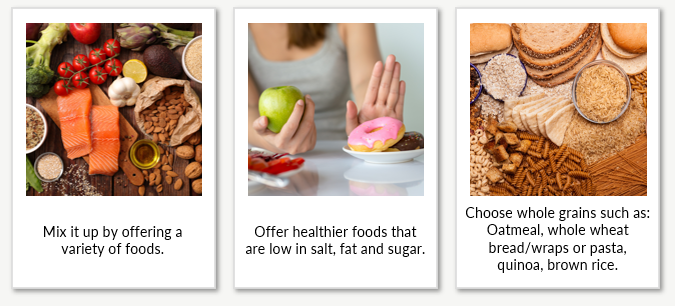Quality Rating 3: Nutritious Meals & Snacks
Instructions
To meet the requirements for Administrative Policies and Practices: Nutritious Meals and Snacks: ADM 4.3, you will upload:
- a nutrition policy explaining that your program:
- monitors food from home
- supplements when necessary
- a weekly menu served within the past month, documenting that fresh fruits and vegetables are served at least two times per week
If you do not serve food or snacks, or you do not allow “outside” food in your program, you may leave a comment for your Program Coordinator. A nutrition policy is still required.
The Policy or Statement Builder provides a step-by-step guide for creating policies for your staff.
Nutrition Policy
A nutrition policy communicates to families the importance of healthy meals and snacks and all that your program does to promote healthy eating habits. There are several benefits to a nutrition policy, including:
- Communicating care and respect for children’s health and development
- Following best practices regarding the children’s health and nutrition
- Outlining a clear plan and guidelines for staff and families to follow related to quality nutrition care
- Promoting consistency related to food and nutrition between your program and home settings
Nutrition policies you should consider:
- Meals, snacks, and foods your program provides
- Expectation about the meals, snacks, and foods families need to provide
- Guidelines and ways your program limits fatty, sugary, and salty foods
- How your program manages food allergies or other dietary restrictions
- Food brought from home for birthdays and other celebrations
- Acceptable and unacceptable (example: candy, soda) food items
- How your program handles unacceptable food items
- Other food policies that are relevant to your program and the children enrolled
What does the documentation look like?
Based on your program’s written food and nutrition policy, families and staff have a clear understanding of the kinds of foods served in your program, as well as foods that are unacceptable. Your policy describes how your program handles nutrition and meal planning, including monitoring food brought from home and supplementing with additional food when necessary.
Weekly Menu
A weekly menu plan shows the foods and beverages your program serves the children for meals and snacks. A written menu plan is a quick visual reference to ensure that a balanced variety of food options are available to the children. Sharing your weekly menu plan with families communicates the careful thought your program devotes to nutrition and healthy food choices, and encourages families to strive for variety and balance in their meal planning at home.
When planning menus, programs are encouraged to:
- Focus on variety, serving sizes, and nutritional content
- Choose foods and beverages that are low in saturated fat, salt, and added sugars
- Choose whole grain options to include in the menu

Long Text Description (PDF)
What does the documentation look like?
Your weekly menu plan clearly shows that fresh fruits and vegetables are served at least two times per week. Circle where these items are found in your menu. Any combination of fruits and vegetables meets the “two times per week” requirement (examples: two fruits, two vegetables, or a combination of fruits and vegetables), although a balance between fruits and vegetables is highly recommended.
Examples:
Fresh Fruits:
Apples, bananas, peaches, pears, grapes, melon, strawberries, blueberries, tomatoes
Fresh Vegetables:
Carrots, celery, broccoli, cucumber, avocado, cauliflower, green peppers
Policy or Statement Builder
Develop a policy that describes your program’s practices on providing nutritious meals and snacks to the children in your program. The Reflection Questions below will help you think about what you do in your program to capture it when creating your policy. Once you have spent time reflecting on the questions below, you’re ready to build your policy.
Reflection Questions
- What are your program’s policies on serving food with fats, sugars and salt?
- How do you ensure that the meals and snacks provided from homes are nutritious and well balanced?
- What do you do if food provided from a child’s home is not nutritious or well balanced?
Policy Builder Resources
Use these optional resources to reflect on your program’s practices and create your Nutrition Policy.
Technology Tips
Choose the way that the provided resources will be most useful to you.
You can:
![]() Download the PDF.
Download the PDF.
![]() Save the PDF.
Save the PDF.
![]() Print the PDF.
Print the PDF.
![]() Edit the PDF.
Edit the PDF.


